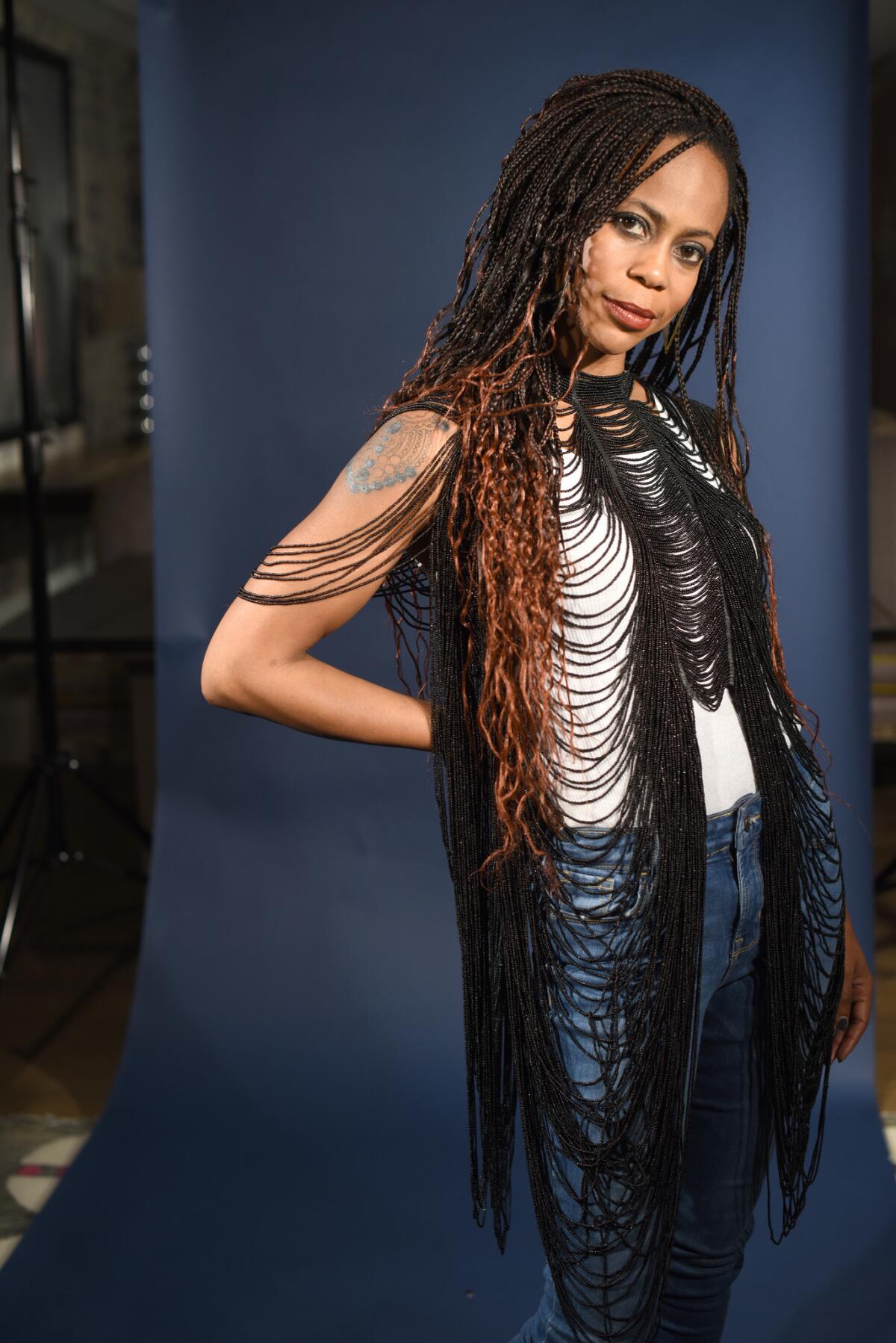Why Beyoncé dances to ‘My Power’ in a church in ‘Black Is King’
- Share via
Between the musical moments of Beyoncé’s “Black Is King” are snippets of spoken word, one of which was written and performed by Joshua Abah.
“When it’s all said and done, I don’t even know my own native tongue,” he said in the piece, which went viral in 2013. “And if I can’t speak myself, I can’t think myself. And if I can’t think myself, I can’t be myself. And if I can’t be myself, I will never know me. So Uncle Sam, tell me this: If I will never know me, how can you?”
These lines are heard as six pallbearers walk slowly through a quiet church. With the exception of the bed of flowers in their hands, the entire scene is white — even their skin, covered in white paint.
It wasn’t always that way. The sequence of the visual album, now streaming on Disney+, was filmed at a church in downtown Los Angeles that was thoroughly transformed by Hannah Beachler, the groundbreaking, Oscar-winning production designer of “Black Panther.”
“That church was anything but white,” she recalled. Beachler, who previously collaborated with Beyoncé on “Lemonade” and the On the Run II tour, worked with a team of over 100 people for 38 hours straight to complete the on-site overhaul — a grueling effort that pays off in its message.
“In America, white is used for weddings, but often in other cultures, it is used in funerals because it is actually the absence of all color,” she explained. So it’s solemn, in a sense.
“Here’s the whole thing about the Black community in this country,” she continued. “We were told that our culture was ghetto and bastardized, and that’s just who we were. And we believed that for a long time. But what we didn’t know, and what we’ve lost from the ancestors, is that we’re none of those things. We are joy and beauty and strength.
“So the way Simba is learning about who he is, we are collectively rediscovering who we have always been,” Beachler added, echoing Abah’s message. “And ‘Black Is King’ is about mourning what we were in order to celebrate what we are.”

Beyoncé’s “Black Is King” premieres Friday on Disney+.
That same church becomes the site of that celebration in the sequence for the song “My Power,” which was directed by Julian Klincewicz and represents the “Lion King” standoff between Scar and Simba. “They’ll never take my power, my power, my power,” goes the chorus of the beat-driven earworm, performed like an anthemic chant. “They feel a way, oh wow.”
The location looks less solemn though, with brighter lighting and a large, flower-like shape on the floor that resembles the West African adinkra symbol Bese Saka, signifying affluence, abundance and unity.
Beyoncé and a handful of dancers stand in as Nala and her pack of lionesses, and stand out against the tableau in vibrant red two-piece outfits. They dance barefoot, executing choreography that simultaneously exudes grace, strength and beauty. (Fans picked up the routine quickly via the #MyPowerChallenge.)

“Being in that space, watching her and those brilliant dancers perform was like nothing I’ve ever experienced in my life,” said Beachler of watching the sequence, shot over four days and featuring the likes of Ernestine Shepherd, the oldest competitive female bodybuilder in the world, and Beyoncé‘s daughter Blue Ivy.
“The music was blaring in the church, and I’m screaming behind a monitor,” she continued. “It was pure power — and not with the caveat of being unapologetic, because there’s no reason to apologize in the first place.”
Giant, angular arches — 8 feet tall, 10 feet wide and 3 feet deep — are stationed throughout the scene and covered in a luxe black-and-white print inspired by an iconic pattern from Alejandro Jodorowsky’s film “The Holy Mountain.” It’s a strategic choice for a visual album that is otherwise mostly set in picturesque landscapes or literal settings, one Beachler said “brings the piece into an abstract and modern space.”
These arches are also arranged into a makeshift tunnel, which doubles as a canvas and a runway for “My Power” musicians Moonchild Sanelly and her signature blue hair, Busiswa in her orange outfit and ornate headpiece and Blue Ivy and Beyoncé in matching colorful ensembles. It is a whole mood when an initially fixed Tierra Whack sheds her heavy black cape to reveal a stunning white jumpsuit, moving freely as she raps.
Though “Black Is King” can be viewed as a problematic portrayal of pan-African identity, “This is not African history or African tradition,” said Beachler.
“It’s understanding all these things that we as Black people have been indoctrinated with and told to [view ourselves] to the point of, ‘You’re a slave’ — because we didn’t just pop up into a cotton field all of a sudden. It’s the idea that who we are has always been in us, even if we didn’t know.
“‘Black Is King’ is just saying, ‘You don’t need to feel shame over your skin,’” she continued. “It’s a love letter to every Black and brown child, saying, ‘You are beautiful, and you have to grow up celebrating that. You cannot grow up like we did.’”
Valentino, Burberry and other luxe labels play a supporting role in the fashion-packed visual album. Here’s a closer look at the outfits and fashion of “Black is King.”
More to Read
The biggest entertainment stories
Get our big stories about Hollywood, film, television, music, arts, culture and more right in your inbox as soon as they publish.
You may occasionally receive promotional content from the Los Angeles Times.











